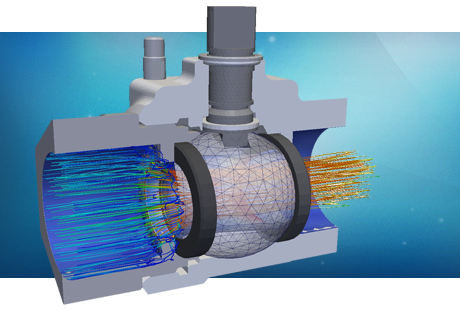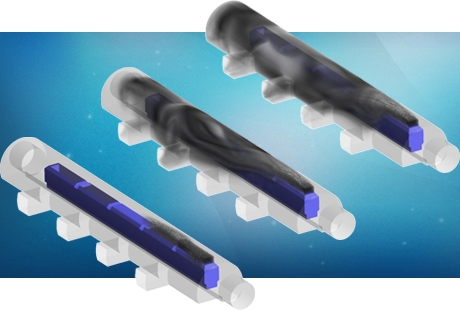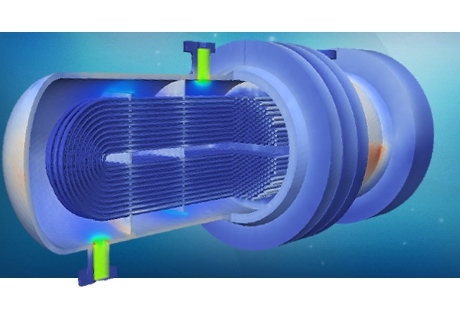Water and waste water processes
The Water Industry is a multi-million pound international business providing clean drinking water and treating wastewater with process engineers having important roles in the design, installation, operation, maintenance and management of the associated treatment processes. A variety of different processes take place on both clean and waste water treatment. Pumping, chlorination, separation and chemical dosing are just a few.

Each treatment process has its own technological challenges and uses very different processing equipment. Whatever the process technology, the use of CFD and FEA modelling is a great advantage for designers and operators. Valuable insight on the fluid dynamics performance, separation efficiency and mechanical aspects such as stress, fatigue and erosion can be obtained at a fraction of the time and cost required to complete similar full or small scale trials.
Chlorination process
Chlorination is the most common disinfection method for public and private drinking water systems. This process is necessary to kill disease-causing bacteria in the water. Disinfection of water using chlorine requires accurate residence times, during which the water/chlorine mixture passes through a Chlorine Contact Tank (CCT) and a significant quantity of chlorine is consumed. Therefore, information regarding the residual chlorine in water supply systems is of great value in managing disinfectant concentrations.
PRE Technologies have developed a set of computational tools to optimise the chemical dosing and contact tank design by means of numerical modelling techniques. A full white paper on water chlorination can be found here.
A transient simulation of the transport of a tracer species is often used to characterize the performance of the CCT. A chemical species is introduced within the non-reacting flow at the inlet of the tank and the concentration of the tracer can be monitored, as a function of time, at the outlet.

From the simulation it is possible to obtain the residence time distribution (RTD) curve to characterize the mixing and flow within the tank and to compare the behaviour of real tanks to their ideal behaviour. This is useful, not only for troubleshooting existing tanks, but in estimating the yield of a given reaction and designing future tanks.

Dead volume fraction, tank efficiency, the reactor dispersion index, also known as the Morrill index (MI) are the key performance indicators that can be obtained from this analysis and that help compare and optimise tank performances. The distribution of fluid age can be also assessed following the method described by Liu and Tilton (2010). The mean age method is an efficient tool to study mixing in steady continuous flow systems providing information of position of dead zones and short circuiting paths inside a vessel.
Chlorine decay throughout the tank can also be assessed knowing the age of the fluid elements inside the CCT and approximating them to perfectly stirred reactors. A first order decay kinetics is often used to describe chlorine consumption in the contact tank. A standard average value for the chlorine decay constant can be used as reported by Brown et al. (2011).
Water pumping
Pumping stations are facilities which include pumps and equipment for pumping fluids from one place to another. They are used for a variety of infrastructure systems, such as the supply of water, drainage and removal of sewage to processing sites. Typically, these structures are designed and assessed by physical scale modelling.

Computational modelling can provide a practical and cost-effective alternative to assess design iterations and identify critical issues in the design of pumping stations at full scale and at a significantly lower cost compared to physical modelling. Our white paper on water pumping can be found here.
Typically, solid deposition and flow rotation at the pump inlets are the most common issues found in this facilities. Flow rotation in the pump pipes can cause wear and has a direct impact on the maintenance costs of the pump. This can usually be avoided or minimized by the placement flow splitters close to the pump intake. Pre-swirl rotation is a measure of the intensity of flow rotation at the pump pipes and can be predicted using computational fluid dynamics (CFD) models.
The ability of the pumping station to maintain solids’ mobility along the floor is also critical to some sectors (e.g. mining or wastewater management) and must also be assessed through CFD modelling. The solids’ transport or settlement is closely related to stagnant zones formed in the pumping station.

Two non-dimensional variables, the Critical Shields Stress and the Boundary Reynolds Number are determined for this solids deposition study. The calculated value of Critical Shields Stress is compared to the limiting condition which marks the boundary between moving and static sediment along the pumping station.
Separation

Cyclonic separation
Hydrocyclones provide the highest throughput-to-size ratio of any water-treating technology and are insensitive to motion or orientation. That is why they are the preferred option in most industries. However the technology is constantly evolving and there are aspects that are still in need of improvement.
Poor efficiency due to the lack of fluid-pressure energy is one of the main issues in modern hydrocyclone installations. This is due to the pressure loss across the distance from the mixture inlet to the treated water outlet and is normally solved by adding a pumping device upstream. Low shear pumps are needed such as progressing cavity or positive displacement pumps. PRE Technologies' white paper on cyclonic separation can be found here.
CFD analysis may help the designer determine the effect of the pumping device, proportional and overflow valves and inlet configurations on the droplet dispersion, thus aiding the optimisation of the cyclone efficiency.
Gravity separation
Gravity separation is completely different in nature to centrifuges and cyclones. It is governed by Stokes’ law which is used to define the steady buoyant rise velocity of a discrete oil droplet in a continuous water phase. Engineers must consider a number of physical aspects when designing gravity separators. Factors such as continuous phase viscosity variations with temperature, range of discrete droplet diameters and emulsion stability have to be taken into account because they dramatically influence the separation performance.

CFD based droplet/bubble trajectory calculations can be used to determine a relationship between vessel length and droplet/bubble cut-out diameters for a given flow rate. Aspects such as fluid turbulence or the effect of the internals such as plate or matrix packs or other shearing devices on the flow patterns can also be accounted for using CFD models. PRE Technologies has a strong background in applying these modelling techniques to simulate a range of expected operational conditions and optimising vessel configurations in a quick and relatively in-expensive manner. Our white paper on gravity separation can be found here.
For more information on other services for water processing systems, please go to the water processing services tab or contact us here.
Our services for this sector
Chlorination
- Contact tanks hydrodynamics CFD modelling
- CFD based residence time distribution (RTD) calculations
- Fluid age and chlorine decay studies
- Solid deposition assessment
Water pumping
- Water pumping facilities hydrodynamics CFD modelling
- Pump inlet optimisation and swirl angle calculations
- Flow splitters evaluation and optimisation
- Solid deposition assessment
Separation
-
Hydrocyclones
- ASME and API compliance assessments for hydrocyclone devices
- Erosion DPM CFD models for wear prediction
- Optimisation of hydrocyclone's fluid dynamics using CFD modelling
- Hydrocyclone stress and fatigue FEA calculations
-
Gravity separation
- Fluid dynamics assessment on separator's inlet device (slugs and foam)
- ASME and API compliance assessments for gravity separation vessel
- Flow distribution zone optimisation using CFD analysis
- API separators and plate coalescers stress and fatigue FEA calculations







